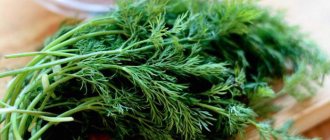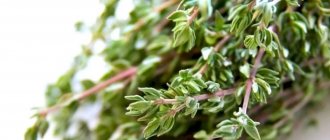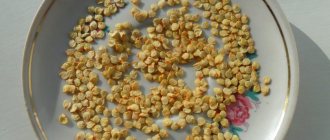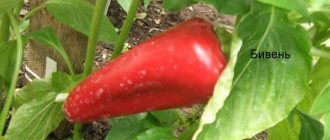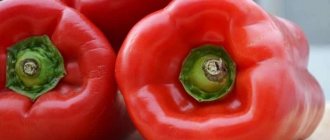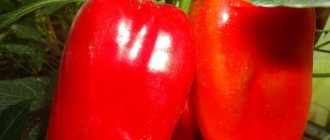Origin of paprika
What is paprika? The plant has several other names: Hungarian, Bulgarian or sweet capsicum.
It appeared in the vastness of Europe thanks to Columbus, who at one time went to India for black pepper, but missed a little and ended up off the coast of Central America. Having tasted the hot pepper, the navigator decided that he was quite capable of replacing black pepper with peas , which in those days was worth its weight in gold.
After Columbus returned to Spain, the monks began cultivating the plant. To turn the fruits into a seasoning, they were collected and dried using smoke from fires. The pepper eventually acquired a smoky aroma and flavor.
In other European countries, peppers were dried in a different way. The fruits were laid out on large trays, slightly dried, then strung on jutes and hung to dry in the sun.
Reference. In modern production, large fans are used, which significantly reduce the production time of the spice.
Paprika received the name “bell pepper” thanks to Bulgarian breeders. Based on the vegetable brought by Columbus, they developed a different variety, with thicker, sweet flesh that lacked pungency. From Bulgaria, pepper came to the southern regions of Russia. Since the 17th century, it began to be actively grown in warm climatic zones.
Over time, new varieties have appeared that tolerate cold well. In the northern regions, paprika is grown indoors. The culture is unpretentious to growing conditions, despite the fact that it needs a sufficient amount of sunlight. In modern conditions, this is achieved using artificial light sources.
What to cook with paprika
The beneficial properties of paprika are determined by the unique chemical composition of sweet peppers, since the spice perfectly retains all the properties of the fruit even after drying.
There is probably not a single national cuisine in the world where spices obtained from pepper are not used. Asian cuisine uses both spicy ground pepper spices and sweet dried flakes. Mexican, and indeed all South American cuisine, rightfully cannot do without this culinary additive - after all, this is the birthplace of pepper culture.
In European cooking, paprika, both powdered and in the form of coarsely ground pieces of fruit, is especially widely used in southern countries - Spain, Portugal, Italy, Bulgaria, Hungary. A classic dish of Austrian and Hungarian cuisine, paprikash is unthinkable without the presence of a large amount of pepper seasoning - sweet red paprika! Paprika is very widely used by German cooks - it is used to flavor soups and sauces (red paprika gives them the same color), cheeses, and sausages.
Green and red paprika flakes are generously added to meat dishes such as beef (the famous goulash!), lamb, chicken, veal, and pork. This seasoning gives the hot dish a unique sweetish, not too spicy taste and aroma. Sweet paprika in any form will not spoil vegetable salads, especially tomatoes and cabbage. Paprika is combined both ground and in flakes with cottage cheese, rice, eggs, seafood, and minced meat.
Sweet ground paprika is readily used by chefs if the main component of the dish being prepared - for example, meat or vegetables - needs to be highlighted with a sweetish spicy taste. Paprika flakes added to a dish swell and increase the volume of food. If these are green paprika flakes, then such an additive will have a slight effect on the overall calorie content. This exact recipe for baking bread with the addition of sweet paprika in the form of flakes is given in the ancient book of Ayurveda.
From ancient times to the present day, sweet paprika has been a seasoning on the table of lovers of tasty and healthy food.
>
471
Beneficial features
Paprika is an extremely healthy vegetable with a unique set of vitamins and minerals. In 1937, Alfred Szent-Györgyi (Nobel Prize winner in medicine), while researching the negative effects of paprika on the human body, discovered a huge amount of vitamin C in the fruit.
As it turned out, the vegetable contains five times more ascorbic acid than lemons. 100 g of paprika contains 150 mg of vitamin C, with a person’s daily requirement of 60 mg. Moreover, an overdose is impossible. Excess leaves the body with urine.
In addition to ascorbic acid, paprika contains:
- vitamins A, B1, B3, B2, B6, B5, B9, E, K, P, C;
- zinc;
- iodine;
- phosphorus;
- iron;
- calcium;
- sodium;
- potassium.
With regular consumption of sweet red pepper, the following occurs:
- increasing immunity;
- improvement of the body as a whole;
- improved blood test results;
- strengthening the cardiovascular system;
- normalization of the processes of food digestion and absorption of nutrients;
- reducing the risk of cancer;
- normalization of metabolism;
- improved vision (especially for myopia);
- increasing the production of endorphins (useful for stress, depression, loss of strength);
- memory improvement;
- strengthening hair and nails;
- reduction of excess weight and swelling;
- normalization of the musculoskeletal system in osteoporosis;
- regulation of blood pressure.
Paprika contains a substance called capsaicin, which thins the blood and reduces the risk of blood clots. Fiber promotes the removal of waste and toxins, improves intestinal motility.
In folk medicine
- Sweet Paprika tincture is used to increase appetite and improve digestion. In addition, green sweet can improve the functioning of the sebaceous glands, strengthens hair and nails. Sweet pepper juice is recommended for people with diabetes. When mixed with carrot juice, its juice lightens age spots, and if you add spinach juice, you get an effective remedy for intestinal colic.
Types of paprika
Paprika varieties differ in fruit shape and pungency. The pungency depends on the amount of capsaicin. Hot pepper contains about 1% of the substance, sweet pepper – 0.01%.
For example, in Hungary the vegetable is divided into seven types, but under the general name “paprika”:
- noble sweet dark red color with a delicate aroma;
- delicate with a slight spiciness;
- tender, not spicy, with a pleasant taste;
- semi-sweet;
- pink medium pungent, pale red in color with an intense odor;
- yellow in color with a burning taste;
- special sweet red.
Application" in cooking and taste of paprika powder
Since this seasoning is in demand in the preparation of various dishes, it is a popular component of Hungarian, Mexican, Bulgarian, and Korean cuisine. Both the color of paprika and its spicy aroma and special taste are used for:
- marinating meat;
- baking chicken, lamb, pork dishes;
- salad dressings;
- preparing sauces;
- white fish dishes;
- stewing vegetables;
- baking;
- replacement of tomato paste.
Paprika can diversify culinary masterpieces if you choose the right variety and quantity for a particular dish.
The taste of the powder depends on the type of vegetable from which it is made. Main types of paprika:
- tender – has a mild taste without any hint of pungency;
- special – has a sweetish taste, suitable for stewing and preparing soups and broths;
- delicacy – characterized by the presence of a spicy odor and mild pungency;
- noble - is a universal seasoning due to its slight bitterness and pleasant aroma;
- semi-sweet – has a medium degree of pungency;
- pink – characterized by a special aroma and slight pungency;
- hot – the hottest of all types of paprika.
Thanks to such a variety of seasonings, everyone can choose the appropriate option based on individual gastronomic preferences.
What is red pepper
Hot red peppers come from America. This is the same crop that was brought by Spanish sailors who went for Indian spices, but by coincidence discovered a new continent.
The shape is not as varied as that of sweet peppers. Often the fruits are round or elongated. The color is yellow, red or dark olive. In Russia, the most common peppers are red, resembling a proboscis.
Culture loves sun and warmth. The ideal environment for growth is greenhouses. If desired, the plant can be grown at home on a windowsill.
The substance capsaicin gives the fruit its characteristic burning taste. The more of it, the hotter the red pepper. The fruits contain:
- carotenoids;
- calcium;
- fixed oils;
- sulfur;
- iron;
- B vitamins;
- ascorbic acid.
Thanks to its rich chemical composition, red pepper has a powerful effect on the body and enhances the effect of medications.
Hot peppers are contraindicated for people suffering from diseases of the heart, kidneys, liver and gastrointestinal tract.
What is the difference between paprika and red pepper?
Are paprika and red pepper the same thing? Our answer is yes! Spices are made from a single plant. The only difference is the degree of spiciness. The fruits of sweet paprika are not spicy or have a slight pungency. Once dried, the pepper is turned into powder or flakes. The taste of the spice depends on the drying method.
There is smoked paprika on sale, which has a pronounced aroma. Hot red pepper is often added to sweet pepper powder. This enhances the taste and adds piquancy.
Ground red pepper is made from hot paprika. The spice is used in cooking, medicine and cosmetology.
What is the difference between paprika and bell pepper
Bell pepper, sweet pepper, paprika are the names of the same culture. Paprika means "pepper" in Hungarian. There are many varieties of paprika in the world of different colors, shapes and sizes, with different taste characteristics and degrees of spiciness.
In Russia, the most popular is bell pepper with thick skin and pulp. In Italy, they prefer the sweet fruits of Peperoncino or Cubanelle, with a thin skin and a fragrant aroma. Spaniards love the hot cone-shaped Piquillo peppers or the sweet Pimento peppers with their delicious aroma and thin skin.
Reference. All varieties of paprika are suitable for making seasoning in powder or flake form.
Historical reference
To be more precise, this confusion has arisen since the time of Columbus.
It was he who mistakenly brought to his homeland from America not black pepper, for which he actually went, however, to India (black pepper represented itself as the fruit of a vine of the pepper family of the genus Piper nigrum), but the fruits of plants of a completely different genus, the one that gives We all love red pepper (Capsicum annuum). Fact: The genus Capsicum annuum does indeed have species of hot fruits, but their plants are not at all vine-like, like true peppers of the genus Piper nigrum.
Columbus brought more than just hot red peppers to his country. Some specimens turned out to be sweet. The Spaniards liked them so much that they began to cultivate this crop on a large scale. Then the “wrong peppers” penetrated deep into the continent and gradually became common property.
How to replace paprika
If we talk about paprika as a seasoning, then if necessary, it can be replaced with ground red or cayenne pepper. Only in this case will you have to regulate the quantity, because these spices have a burning taste.
Sweet paprika powder often lacks pungency. When purchasing seasoning bags, pay attention to the composition. Some manufacturers add hot pepper to it to enhance the taste.
The usual powdered seasoning will be replaced by smoked paprika flakes. As an alternative, use cinnamon, nutmeg, black or allspice, and curry seasoning.
Paprika seasoning: its description and features
Paprika has two meanings:
- This is red pepper powder;
- this is a collective name for plants whose ripe fruits are used for processing - they are ground and obtained as a spice.
Description of paprika and its preparation technology:
- The raw material used is a special variety of pepper that grows in warm regions.
- Only ripe fruits are selected that have a deep red color with a purple tint or are painted in bright orange tones.
- The heat depends on what type of pepper was chosen, but it is not very hot.
- The collected ripe fruits are first dried and then ground.
Additional Information! At its core, paprika is a bell pepper from which high-quality fruits that are ideal in all their characteristics are selected.
Therefore, answering the question of how paprika differs from bell pepper, we can say that, in fact, nothing. They are both varieties of capsicum.
Only high-quality, selected harvests are taken into the production of seasonings
Paprika is a unique seasoning that has the following features:
- if you blow on it, it instantly scatters over long distances;
- color - red, but a yellowish tint in the form of inclusions is allowed;
- stable consistency - the spice does not form lumps or flakes when you touch it;
- good solubility in water, to which the seasoning gives a uniform red color.
Paprika is both a vegetable, a dye, and a spice.
Note to the hostess
When using spicy spices, you should take into account some nuances in preparation:
- Paprika “does not like” high temperatures. Over high heat or in boiling fat, it can burn instantly, causing the dish to change color and develop a bitter taste. Strictly speaking, the temperature of boiling water is the maximum that paprika can withstand.
- The spice gives off its color and taste best if it is added to hot fat and the dish is cooked over medium heat. For example, it can be added to the fry at the very end of cooking, and then mixed with the main product (rice, goulash), pour all the ingredients with broth and bring everything together until cooked.
- Experienced cooks reduce the excessive spiciness of this ingredient in the following way: either add it to the pan a couple of minutes before cooking (for example, in first courses), or sprinkle the ground spice on almost finished food (for example, porridge, stewed vegetables, etc.). And what’s interesting in this case is that such a use will not affect that pleasant reddish tint of the prepared food, which is so appreciated by chefs and gourmets.
- To make the color of paprika dark burgundy and the taste a little brighter, you need to: before adding paprika to the dish, fry it in a dry, preheated frying pan over low heat, stirring constantly.
Not a single dish is complete without spices to one degree or another. Some seasonings add spice to food, others add aroma, and others color it in bright colors that stimulate the appetite.
Paprika is one of these spices. Many people believe that this is a specially grown vegetable plant. But in fact, this is the name given to red peppers of sweet and semi-hot varieties, which are used for preparing various dishes and canning.
If such a pepper is picked unripe, it will be green. Housewives are accustomed to stuffing this pepper. But when ripe, sweet peppers acquire a red or orange-red color. And regardless of the taste, it is called paprika.
Paprika is popular in many countries, but it is still in great demand in Spain, Hungary and Bulgaria. That's why everyone calls this pepper Bulgarian. Although the main industrial plantations of this vegetable are located in Hungary.
Paprika does not have a pronounced aroma (compared to other herbs), so it is most often used in dishes to color them. But still, this spice adds a piquant note. Red pepper is not only valued for its taste, but it is also very healthy.
The mystery of paprika pepper: application, difference from bell pepper, photo
Paprika pepper grows all over the world. Its homeland is considered to be the USA (an area with a tropical climate), where the plant grows wild today. More often it can be found in southern and eastern countries with a temperate climate. However, paprika is also grown in the northern parts of the world as a houseplant. This vegetable is actively grown in the southern CIS countries.
Subspecies of paprika
Currently, vegetable paprika has many varieties, among which are:
- poblano;
- jalapeno;
- cayenne;
- yellow;
- serrano;
- Anaheim;
- capsicum chinensis;
- berry;
- pubescent and others.
Each variety has its own fruit shape and taste. Some varieties have a sweet or spicy taste, while others have a spicy taste. The level of bitterness depends on the amount of capsaicin. Spicy varieties contain much higher capsaicin than sweet varieties. Fans of cooking and gardening know that the statement that paprika is a bell pepper can only be considered partially true. Both are types of capsicum.
In general, peppers can be divided into three types:
- paprika (or spicy);
- hot burning;
- sweet.
Almost all popular varieties belong to one of these types. The difference between paprika and sweet pepper lies in some flavor nuances; they have a mild hot taste and are popular when preparing salads.
Paprika or bell pepper, grown in the CIS countries, belongs to the species Capsicum oblique. The Capsicum vegetable long species mostly includes spicy varieties that are grown in vegetable gardens.
Chemical composition
Sweet peppers contain a huge amount of useful substances - carbohydrates, fats, proteins. These vegetables contain ascorbic acid, B vitamins, vitamin C, E, A, carotene, magnesium, calcium, zinc, sodium, potassium, copper, fluorine, iodine, folic acid, iron, nicotinic acid.
The carbohydrates that make up paprika are presented in the form of soluble sugars - fructose, glucose, sucrose. The sweet vegetable also contains fiber, starch, organic acids, pectin, and nitrogenous substances (50% of them are protein).
Contraindications
Dishes with the addition of paprika are not recommended for people with diseases of the liver, kidneys, gastritis, colitis, cholecystitis, stomach and duodenal ulcers.
Also, a contraindication to its use is individual intolerance, and during pregnancy and breastfeeding it is undesirable to consume spicy varieties in large quantities.
Paprika in cooking
- Hot and mildly hot are widely used in cooking as a seasoning for many dishes, as well as for pickling. In addition, the pungent pungent is used in medicine and in the distillery industry.
- Paprika is most beneficial when eaten fresh, for example when added to salads. Canned pepper retains about 50-80% of its nutrients, which is especially important in winter. For pickling, they mainly use slightly unripe sweet.
- Hot pepper is used to add to seasonings, and also as an independent spice. It is added to meat dishes, soups, and vegetable dishes. In raw and boiled form, sweet and slightly hot, it is eaten with meat, cheeses, and is also used to make salads.
In medicine
- Acute Studies have found that the substance capsaicin, which is part of paprika, can increase acidity and increase the production of gastric juice. For medicinal purposes, mainly hot varieties with large red fruits are used. Tinctures and ointments containing hot pepper are effective for rheumatism, neuralgia, myositis, radiculitis, and frostbite. Pepper plaster is an excellent alternative to mustard plasters.
How to make ground paprika (spice)
- Ripe sweet pepper fruits are washed and dried from water.
- Cut and remove seeds and partitions.
- Cut into small pieces and place on a baking sheet lined with parchment.
- It is advisable to dry the pepper a little before drying so that some of the moisture evaporates from it.
- Drying is carried out in the oven at 60° until completely dry. It is better to keep the door ajar. Ultimately, all the pieces should be hard and, when bent, not bend, but break. A kilogram of fresh pepper yields about 50 g of dry paprika.
- The paprika is dried in air and then ground into powder in a coffee grinder or blender. Thoroughly dried paprika is easy to grind and stores well.
- Store in a glass jar with an airtight lid in a dark, dry place.
If you want to get paprika with a sharper taste, it is dried along with the seeds (the number of seeds affects the bitterness) and ground.
If the weather is sunny, then the paprika can be dried in the sun. But you need to turn it over often so that the pepper pieces don’t get moldy.
My favorite recipes
Interesting articles
- My dream kitchen – what is it like? 02/20/2020
- What is cooked for Paska in different countries of the world? 18/02/2020
- How to make yogurt with and without sourdough? 09/01/2020
- A great gift for the New Year - wooden educational toys! 05/12/2019
- Menu for New Year 2021! 28/11/2019
- Farm products - start eating natural! 11/19/2019
In the event of a breakdown of kitchen appliances, microwave ovens can be repaired.
Hot red pepper and sweet paprika - what are the differences?
In the kitchen, every housewife, of course, has a special shelf with different spices, where there is black, red pepper , chili pepper or ground paprika . All these spices not only complement our dishes with their pungency and piquancy, making them much tastier, but also with healing properties. It often happens that, not having sweet paprika on hand, we use red pepper, hoping that it is the same thing. However, this makes the dish too spicy. Or, on the contrary, the dish should turn out to be spicy and spicy, but by adding sweet paprika, we thereby violate the recipe, as a result of which the dish turns out not as expected. This is exactly what happened to my regular reader, who, while cooking Pork in beer for her husband, added chili pepper instead of sweet paprika - the dish turned out tasty, but too spicy. My husband liked the dish, but the hostess herself only tried the pork; it was too spicy for her. Her comment gave me the idea to figure out what is the difference between red pepper and sweet paprika - after all, these spices are very similar in appearance.
Red pepper is a well-known seasoning. There are several varieties of red pepper, which differ in the type of pod, size, color, and degree of heat. The pepper with the least heat and sweet flavor is called paprika. Hot varieties of red pepper are used as a spice, the quality of which is determined by their heat, pungency and color intensity. Interestingly, the degree of heat depends on the amount of a special substance contained in the pepper, called capsaicin, as well as on the methods of its processing. Seasonings made from whole peppers are hotter and hotter. High-quality pepper should be mildly spicy, have a beautiful red color, and also have a delicate aroma. Storage conditions also affect the quality of the spice. For example, red peppers in a dry, dark place with good ventilation and low humidity. The temperature should not exceed +8 degrees. In cooking, hot red peppers are used in the preparation of sausages, cutlets, jellies and much more. The spice is ideal for meat and vegetable dishes and is used in preparing rice and bean dishes. This spice will add a special piquancy to chicken, fish or seafood. The seasoning is also added to many salads, cheeses, and cottage cheese dishes. Red capsicum is even used in the production of some alcoholic beverages, for example, vodka or liqueur. Adjika and ketchup are prepared from ground pepper; it is added to broths, borscht, and soups. In addition, the spice goes well with other spices, such as basil, garlic and coriander.
One variety of red bell pepper used is sweet paprika . It belongs to a very noble seasoning, which has a dark, rich color and a refined aroma. There are several types of paprika - semi-sweet, delicacy and pink. The only difference between them is the sharpness, color and degree of grinding. One of the most famous is pink paprika, which is a spice that has a piquant, pungent taste. There are several varieties of pink paprika , with the most popular variety being Bulgarian, which is distinguished by its bright red color and mild, sweetish taste. Paprika can be used to prepare a wide variety of meat and vegetable dishes, soups, sauces; it can be added to goulash, rice, salads, as well as seafood and egg dishes. Sweet peppers combined with other spices, such as garlic, basil or coriander, are perfect for making mashed potatoes. Typically, ground paprika . Its unusual feature is that when heated, it can turn food red. You should not use paprika for cooking fried foods, as it burns quickly, acquiring a bitter taste.
I hope that this small but informative article will help you understand the properties of these seasonings and their correct use. Cook with pleasure, and you will succeed!
Note to the hostess
- Dry paprika is rich in sugar, and it is known to caramelize when fried. Therefore, if a recipe calls for adding paprika to vegetables or meat during frying, you need to make sure that it does not burn. Otherwise, it will darken greatly and the taste will become worse.
- High-quality paprika should be red or red-orange in color, without a musty smell. If it is dull in color and gathers in lumps, then it is better to refuse to purchase such a spice.
- Paprika goes well with bay leaf, parsley, savory, dill, celery, onion and garlic.
- Paprika is added at the end of cooking. This preserves the color and aroma of the spice. The exception is marinades.
Paprika is a red sweet pepper from which the seasoning of the same name is made. In the 17th century, this “red gold” was brought to Hungary from South America, which is the birthplace of the plant. In the Serbo-Croatian language, a suitable word “papar” was found to name the overseas product, and later it was transformed into “paprika”. Later, paprika spread throughout European territory, but in Russia it appeared only at the beginning of the twentieth century, but this did not prevent local culinary experts from appreciating its true value.
Paprika seasoning is a powder ground from sweet or mildly hot dried pepper. The meat used for production is red, fleshy, juicy peppers, which are dried in the sun and then ground. There are many varieties that vary in color and pungency, so the color of the seasoning varies from light yellow to brownish-red. However, the best for making seasonings is considered to be red bell peppers, which have a sweet taste and strong aroma; these peppers are peeled from seeds and core, dried and then ground into powder. The result is a warm red spice with a slightly sweet aftertaste.
Pink paprika is considered more rich and spicy. There is a delicacy variety that is not spicy at all, it is semi-sweet and is liked by many spice lovers. Its characteristic feature is the external shine of the powder. But most often the noble one is used in cooking, since it has the brightest aroma, and its color is very dark and rich.
Spice application
Paprika is loved in cuisines such as Mexican, German, Hungarian and Spanish. Almost no meat dish can do without it, especially pork or chicken. But you need to remember that you cannot add paprika when frying, because it has the unpleasant property of burning quickly, and as a result its taste and aroma are lost. Vegetables also go well with this spice, especially cabbage and tomatoes. Many sauces and soups are prepared with the addition of paprika.
The famous dish “paprika chicken” is the hallmark of Hungarian cuisine. The famous barbecue seasoning is also not complete without red powder. And even ordinary mashed potatoes become just a festive side dish if you flavor it with basil, savory, garlic and paprika. In addition, paprika gives dishes not only taste and aroma; when heated, it gives food a reddish or orange color.
When choosing this spice, you need to remember that a good quality product should have a bright color, if it is dull or has a dirty gray color, then such a product is of the lowest grade or it was stored improperly. At home, you need to store paprika in a dark and cool place, as the sun's rays destroy it.
Composition and beneficial properties
Paprika boasts a high content of vitamin C, even more than lemons. With this seasoning you can improve blood circulation, improve appetite, improve digestion and the condition of the pancreas; it is also useful for rheumatism.
Interestingly, paprika is one of the four main Hungarian products (other than sour cream, pork fat and flour). Every year the average Hungarian eats half a kilogram of paprika. But not only in this country is the red spice respected; in the Balkans they eat 200 g of it per year, and the Germans consume 100 g of it per person annually. But still, in Hungary, paprika is loved most of all; there is already a unique museum dedicated to this product, and the national Hungarian dish is none other than paprikash.
Harm and contraindications
This spice is contraindicated for hypertension, arrhythmia, severe forms of coronary artery disease, gastric and duodenal ulcers, ulcerative colitis, acute pancreatitis and cholecystitis, gastritis with high acidity of gastric juice, liver and kidney diseases, chronic hemorrhoids, insomnia and in case of individual intolerance.
| Paprika is a special seasoning made by grinding red pepper. Quite often, red pepper itself is called paprika. Traditionally ground paprika has a sweet taste. However, paprika can be very hot and also slightly spicy. The taste of paprika directly depends on the type of pepper used. Hot paprika is made from chili peppers, while the rest is made from regular varieties of red peppers. There are three types of paprika on sale: chopped, ground and crushed. The seasoning can have different colors, ranging from light yellow flowers to a bright red hue. A dirty brown spice should alert buyers, as this color indicates that the spice was not stored properly and is of poor quality. Under no circumstances should you store paprika in a bright place, because when exposed to sunlight, the seasoning will lose its pleasant taste and exquisite aroma. |
Which one to buy?
The first thing you need to pay attention to is the consistency of the powder. You can evaluate the color and taste later, when you make sure that the grinding is uniform and the seasoning is dry and crumbly. Clumping and uneven structure appear when stored improperly. The color is not necessarily red; paprika is also found in green and yellow. The smell should be pleasant and soft, the taste should be without harsh notes, sweetish.
The best paprika is factory-made, hermetically packaged, from well-known brands. But if you are at the Hungarian market or in Transcarpathia, you can buy some local seasoning in bulk. The locally produced spice is good because it is definitely fresh and made from good raw materials. The quality of the product in this case is the key to prosperity, so manufacturers (and they are also traders) religiously adhere to technology.
Offers on IHERB
The Californian company offers consumers more than 30 thousand types of natural products from well-known manufacturers. Among this variety there is also paprika. The offers include products from the Simply Organic brand – Paprika and Organic Smoked Paprika. And Frontier Natural Products offers ground Spanish paprika.
Offers on OZON
The leader of Russian online trade has three names - ground red paprika and red paprika flakes from Tsarskaya Priprava, ground sweet paprika from the Austrian company Kotanyi. The description of the goods can be read on the website, where the cost and weight of the packaging are also indicated.
